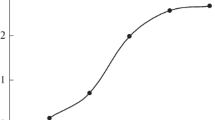Summary
The optimum experimental conditions for the spectrophotometric determination of trace amounts of cobalt(II) in aqueous solutions using chlorindazon DS were assessed and the procedure was described. A 5.5-fold molar excess of the reagent is required for complete complex formation. Heating at 60° for 20 min or at 100° for 5 min is required for complete colour development. The system conforms to Beer's law; the optimum range for a 1-cm cell is 0.4–1.4 ppm of cobalt, determined with a relative standard deviation of 0.5%. The molar absorptivity at 638 nm is 3.25×104l mole−1 cm−1. Cyanide seriously interferes with the determination. A reaction ratio of 1 to 3 for cobalt to the reagent has been deduced from spectrophotometric data. This method was utilized to determine cobalt in a steel sample.
Zusammenfassung
Die optimalen Bedingungen für die spektrophotometrische Bestimmung von Kobalt(II)-Spuren in wäßrigen Lösungen mit Chlorindazon DS wurden ermittelt und die Arbeitsweise angegeben. Ein 5,5-facher molarer Überschuß ist für die vollständige Komplexbildung nötig. Zur endgültigen Farbentwicklung ist es nötig, 20 min auf 60° oder 5 min auf 100° zu erhitzen. Das Reaktionssystem entspricht dem Beerschen Gesetz. Die optimale Menge bei Verwendung von 1-cm-Küvetten ist 0,4–1,4 ppm Co, die relative Standardabweichung 0,5%. Die molare Extinktion bei 638 nm beträgt 3,25·104l·mol−1·cm−1. Cyanid stört stark. Kobalt setzt sich mit dem Reagens im Verhältnis 1∶3 um. Das Verfahren wurde zur Co-Bestimmung in Stahlproben verwendet.
Similar content being viewed by others
References
D. F. Boltz and M. G. Mellon, Analyt. Chemistry48, 216 R (1976) and other biennial reviews published previously in the same journal.
A. Garcia De Torres, M. Valcarcel, and F. Pino-Perez, Analyt. Chim. Acta68 (2), 466 (1974).
R. Belcher, S. A. Ghonaim, and A. Townshend, Talanta21, 191 (1974).
S. Shibata, M. Furukawa, and E. Kamata, Analyt. Chim. Acta73, 107 (1974).
S. Shibata, M. Furukawa, and K. Goto, Talanta20, 426 (1973).
H. Schweppe, Z. analyt. Chem.244, 312 (1969).
D. Molch, H. Koenig, and E. Than, Z. Chemie, Lpz.14, 369 (1974);
Z. Chemie, Lpz.14, 408 (1974).
D. Molch, H. Koenig, and E. Than, Z. Chemie, Lpz.15, 361 (1975);
15, 410 (1975).
G. F. Kirkbright, Talanta13, 6 (1966).
W. C. Vosburgh and G. R. Cooper, J. Amer. Chem. Soc.63, 437 (1941);
R. K. Gould and W. C. Vosburgh, J. Amer. Chem. Soc.64, 1630 (1942).
F. A. Cotton and G. Wilkinson, “Advanced Inorganic Chemistry”, 3rd ed., New York: Interscience. 1972; p. 878
F. A. Cotton and G. Wilkinson, “Advanced Inorganic Chemistry”, 3rd ed., New York: Interscience. 1972; p. 883.
Author information
Authors and Affiliations
Rights and permissions
About this article
Cite this article
Cham, S.F., Lau, O.W. Spectrophotometric determination of cobalt with chlorindazon DS. Mikrochim Acta 71, 241–250 (1979). https://doi.org/10.1007/BF01196410
Received:
Issue Date:
DOI: https://doi.org/10.1007/BF01196410



